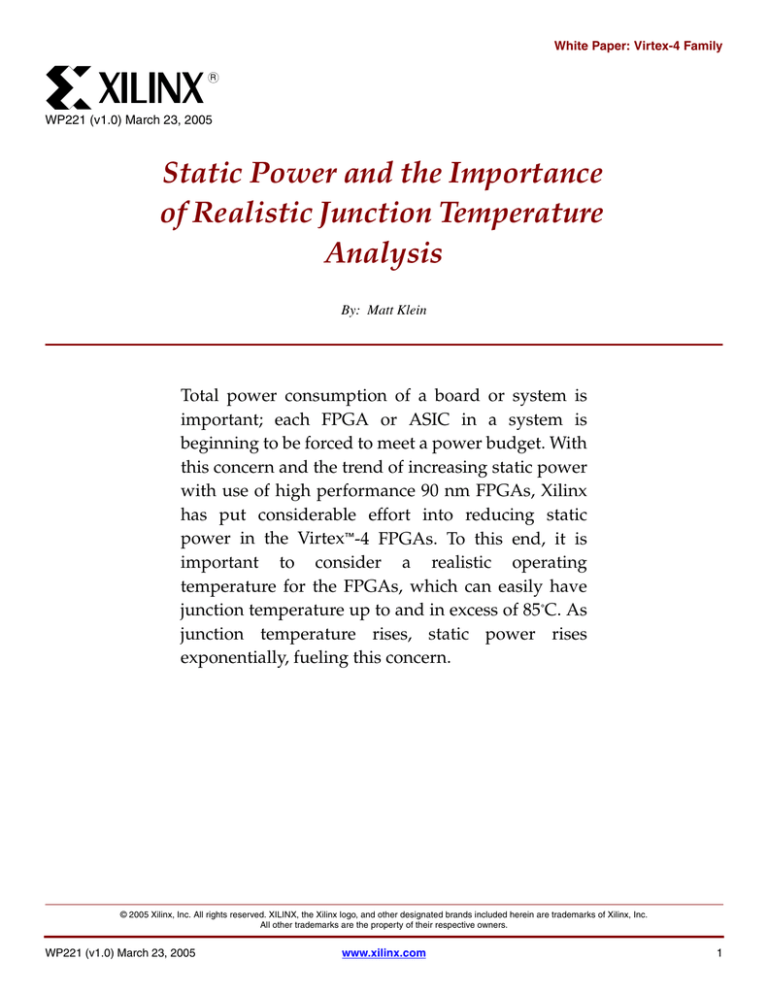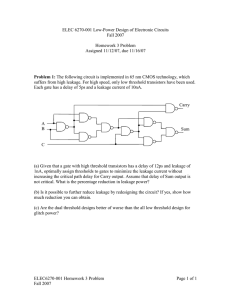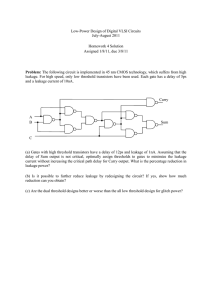
White Paper: Virtex-4 Family
R
WP221 (v1.0) March 23, 2005
Static Power and the Importance
of Realistic Junction Temperature
Analysis
By: Matt Klein
Total power consumption of a board or system is
important; each FPGA or ASIC in a system is
beginning to be forced to meet a power budget. With
this concern and the trend of increasing static power
with use of high performance 90 nm FPGAs, Xilinx
has put considerable effort into reducing static
power in the Virtex™-4 FPGAs. To this end, it is
important to consider a realistic operating
temperature for the FPGAs, which can easily have
junction temperature up to and in excess of 85°C. As
junction temperature rises, static power rises
exponentially, fueling this concern.
© 2005 Xilinx, Inc. All rights reserved. XILINX, the Xilinx logo, and other designated brands included herein are trademarks of Xilinx, Inc.
All other trademarks are the property of their respective owners.
WP221 (v1.0) March 23, 2005
www.xilinx.com
1
R
Introduction
White Paper: Static Power and the Importance of Realistic Junction Temperature Analysis
Customers expect FPGA and ASIC vendors to reduce cost and increase performance.
Typically, this was achieved in the past by reducing transistor sizes, hence increasing
the performance and decreasing the die area and cost.
Reducing transistor sizes increases transistor leakage current, and therefore static
power. With 90 nm technology in FPGAs or ASICs, there is a particular challenge to
reduce static power. A further problem is that leakage rises dramatically with junction
temperature. This white paper describes where static power comes from and its
variation with temperature, providing insight into how Virtex-4 FPGAs address
decreasing static power. Xilinx leverages its vast experience as the industry leader,
producing millions of 90 nm FPGAs, to research this issue and consequently reduce
power in 90 nm Virtex-4 FPGAs.
Even though system speeds are increasing, core voltage is dropping, which reduces
the rate of increase of dynamic power; however, static power is growing exponentially
over time as we move to smaller and smaller technology nodes because of increasing
transistor leakage. Figure 1 from the International Technology Roadmap for
Semiconductors (ITRS) shows a cross-over point as the industry arrives at 90 nm and
smaller technology nodes, where static power is beginning to eclipse dynamic power
for many applications.
Static Power Significant at 90 nm
Normalized Power
500 350 250 180 130
100
90 65
45
22
Technology Node (nm)
1
Dynamic Power
0.01
International
Technology Roadmap
for Semiconductors
(ITRS) 2001, 2002.
Courtesy: Moore’s Law
Meets Static Power,
Computer, December 2003,
IEEE Computer Society
0.0001
Static Power
(leakage)
0.0000001
1990
1995
2000
2005
2010
2015
2020
wp221_01_032305
Figure 1: Static and Dynamic Power vs. Technology Node
2
www.xilinx.com
WP221 (v1.0) March 23, 2005
White Paper: Static Power and the Importance of Realistic Junction Temperature Analysis
Decreased
Power Lessens
Other System
Design Issues
R
FPGAs are being used increasingly in many applications, so reducing power
consumption in FPGAs provides huge benefits to the system design. Some of the key
benefits are shown below:
•
•
•
Fewer thermal concerns - lower power causes smaller rise in junction
temperature, preventing thermal runaway:
♦
Use smaller heat sinks or no heat sinks at all.
♦
Allow for a simpler system thermal design requiring less airflow and smaller or fewer
fans.
Lower cost power system - reduced power requires smaller power supplies:
♦
Power supplies cost from $0.50-$1.00/Watt.
♦
Additionally, there are some total power system considerations where it is important to
stay below a step function jump, such as < 500 W, < 1 KW, etc. If the design is at the
border, every watt counts.
♦
A smaller and simpler power circuitry means:
-
Fewer components.
-
Smaller PCB.
Higher system reliability - running with reduced power lowers the junction
temperature, and lower junction temperature improves reliability.
Since total power consumption of a board or system is important, each FPGA or ASIC
in a system must meet a power budget. Users need to design within the power budget
while being pushed to higher performance and lower cost - a rather difficult challenge
at 90 nm. With this in mind, Xilinx has put considerable research and development
into reducing static power in the Virtex-4 FPGAs and actually reversed the trend for
high static power in a high performance 90 nm FPGA.
WP221 (v1.0) March 23, 2005
www.xilinx.com
3
R
Where Does
Leakage and
Static Power
Come From?
White Paper: Static Power and the Importance of Realistic Junction Temperature Analysis
A well-known rule of semiconductor physics is that when transistor length decreases,
leakage current increases. Smaller physical distances make it easier for current to leak.
Both source-to-drain leakage and gate leakage are inversely proportional to channel
length and gate oxide thickness, respectively, and show a dramatic increases in
leakage. Static power is the power consumed due to leakage in the transistors even
when the transistors are not switching. Therefore, power is consumed in the FPGA
even when it isn’t performing a task.
The leakage is dramatically influenced by junction temperature. This is why it is
important to look at realistic junction temperatures for the FPGAs in the system to
properly account for static power. Figure 2 shows the dramatic increase in ICCINTQ, the
leakage or static current for the core transistors in the FPGA.
Static Current
ICCINTQ Leakage Current
ICCINTQ vs. Junction Temperature
Junction
Temperature
(TJ °C)
Normalized
ICCINTQ Typical
25
1.00
50
1.46
85
2.50
100
3.14
ICCINTQ
100 °C
85 °C
50 °C
25 °C
-40
-20
0
20
40
60
80
100
120
140
Junction Temperature °C
Leakage Increases Dramatcially with Junction Temperature
wp221_02_032305
Figure 2: Leakage Current vs. Temperature for 90 nm Virtex-4 Devices
Two components contribute to leakage:
•
4
Source-to-Drain Leakage: This current flows from source to drain of the transistor,
even when the transistor gate is off. When the transistor gets small, it is harder to
prevent this current from flowing, and therefore, 90 nm transistors tend to exhibit
source-to-drainage leakage with much greater magnitude than larger transistors,
all parameters being equal. The other problem is the thickness of the gate oxide. A
thinner oxide allows the transistor to be switched on and off faster, but it also
increases leakage. The amount of leakage is also influenced by the threshold
voltage of the transistor. The threshold voltage, or VT of the transistor, is the
voltage between the gate and the source at which the channel conducts current to
a certain extent. Small high-speed transistors need a lower threshold voltage
(influenced by oxide thickness and doping) to maintain the speed with which the
transistor can be turned on and off via gate control, but this also tends to increase
the leakage because the channel of the transistor can not be turned off completely.
The goal is to make fast transistors, but unfortunately, physics is against this.
Another important note is that source-to-drain leakage increases exponentially
with increasing temperature; in going from a junction temperature (TJ) of 25°C to
85°C, it goes up by a factor of 5x (see IS →D, Figure 3, page 5).
www.xilinx.com
WP221 (v1.0) March 23, 2005
R
White Paper: Static Power and the Importance of Realistic Junction Temperature Analysis
•
Gate Leakage: This current flows from gate to substrate. This component of
leakage is now more substantial as transistor gate oxide thickness has decreased
at the 90 nm technology node. At room temperature, the leakage from gate to
substrate is larger than the source-to-drain leakage in the 90 nm fast thin oxide
transistors; however, unlike source-to-drain leakage, this gate leakage only
increases marginally with increased temperature (see IGATE, Figure 3).
Static Current Components
Leakage Components vs. Junction Temperature
ICCINTQ
Gate
Source
IGATE
Drain
Leakage ICCINTQ
IS→D
IS→D
IS→D
ICCINTQ = IS→D + IGATE
IGATE
-40
-20
0
40
20
60
80
Junction Temperature °C
100
120
140
Gate Leakage Dominant at 25°C, Source to Drain Dominates at High Temperature°
wp221_03_032305
Figure 3: Leakage Current Components versus Temperature for the 90 nm Virtex-4 FPGA
The net effect is that total leakage ICCINTQ = IS →D + IGATE goes up by 2x - 3x between
25°C and 85°C.
FPGAs and ASICs are getting larger and larger due to requirements of hardware and
system designers. This means that with parts the size of the new Virtex-4 LX200, there
are upwards of one billion transistors to worry about. A leakage of 10 nA per
transistor amounts to a leakage of 10 A!!
There is a silver lining for FPGA manufacturers that is not applicable to ASIC
manufacturers: Xilinx has solved the issue of high static power in the Virtex-4 device,
a high performance 90 nm FPGA, by using triple-oxide.
WP221 (v1.0) March 23, 2005
www.xilinx.com
5
R
What is TripleOxide and How
Does It Affect
Static Power
White Paper: Static Power and the Importance of Realistic Junction Temperature Analysis
Triple-oxide simply means that we use a third thickness of gate oxide in making some
of the transistors in the FPGA (two oxide thicknesses are used in devices like the
Virtex-II Pro FPGA). Most transistors in the past had a thin oxide layer, some with
NMOS or PMOS transistors that operate at either low VT or regular VT. Thick-oxide
transistors are mostly used for I/O drivers.
Oxide deposition thickness is a very stable and controllable process in the
semiconductor industry because it depends on temperature, concentration, and
exposure time. Figure 4 shows the Virtex-4 transistor with the middle oxide thickness
used in the triple-oxide process. The oxide thickness is still very, very thin, but this
thicker oxide transistor has much lower leakage than the standard thin-oxide low VT
and regular VT transistors used in Virtex-II Pro FPGAs and in various parts of Virtex-4
FPGAs.
Industry’s First 90 nm
Triple-Oxide Technology
Source Metal
Connection
Drain Metal
Connection
Gate Oxide
Gate
Source
Channel
Drain
Only Xilinx FPGAs Benefit From This Technology
wp221_04_032305
Figure 4: Middle Oxide Thickness Virtex-4 Transistor Used in Triple-Oxide Process and with
Highlighted Portions of the Transistors
6
www.xilinx.com
WP221 (v1.0) March 23, 2005
White Paper: Static Power and the Importance of Realistic Junction Temperature Analysis
Why Doesn’t
Everyone Use
Triple-Oxide?
R
If triple-oxide is such a great process, why don’t other companies like Intel or IBM use
it in their own ASICs? They probably would if it benefited them. The reason they don't
is that all of their transistors need to run at speed; hence, they must use the low VT,
leakier transistors for everything.
Unique to SRAM-based FPGAs and in contrast to ASICs, all transistors don't need to
be the smallest, fastest, high-leakage transistors. FPGAs use a large number of
transistors (up to 1/3 of those in the FPGA) to hold the design-specific settings for the
interconnect transistors and the logic functions. These are the configuration memory
cells. Additionally, the interconnect pass transistors, while they need to be fast at
passing a signal from source to drain, don't need to be switched on and off rapidly
(controlled by changing the gate voltage). The connections in the FPGA are known in
advance. A transistor that doesn’t need to have its gate switched rapidly doesn't need
to be a thin oxide leaky transistor at all, low VT or otherwise.
Triple-Oxide
and What It
Does to Reduce
Static Power
Xilinx already has had experience with 90 nm FPGAs for a few years through the
deployment of the Spartan™-3 FPGAs. Consequently, a few important things were
learned. The Spartan-3 is a medium performance FPGA, primarily optimized for the
lowest possible cost. In contrast, the Virtex-4 FPGAs are primarily optimized for very
high performance along with decent cost reduction. When using 90 nm transistors of
the highest performance, the leakage described above becomes very large; so what
wasn't a problem in the Spartan-3 FPGAs would have been a problem in Virtex-4
devices had it not been for the early realization of this leakage issue by the Xilinx IC
design team.
Triple-oxide means that in addition to thin-oxide, small, fast, transistors for the FPGA
core and thick-oxide, higher voltage, swing transistors for the I/O, we have
introduced a third middle-thickness transistor, which can be used for configuration
memory cells and interconnect pass transistors. These transistors operate at a higher
threshold voltage than the thin oxide transistors.
So, the bottom line is that if a design uses hundreds of millions of transistors in a highperformance 90 nm FPGA, the transistors can be lower leakage middle-thickness
oxide, which greatly reduces leakage without compromising performance in the
FPGA. The net effect is that the total FPGA leakage is substantially lower than that of
a similar-sized FPGA that doesn't use triple-oxide.
If a high-performance FPGA is made without using triple-oxide to substantially lower
the total leakage, not much can be done after the fact; as mentioned earlier, raising
threshold voltage via doping changes or increasing oxide thickness can’t reduce
leakage affecting performance.
Xilinx made smart choices at the begining of the design phase. In addition to tripleoxide, Xilinx IC designers balanced gate lengths and gate widths of transistors,
voltage thresholds, and circuit design to create a high-performance 90 nm FPGA with
low leakage.
WP221 (v1.0) March 23, 2005
www.xilinx.com
7
R
White Paper: Static Power and the Importance of Realistic Junction Temperature Analysis
Figure 5 shows leakage amounts for the the Virtex-4 device compared to the 130 nm
Virtex-II Pro device and other 90 nm high performance FPGAs at 85°C. This data is
based on prediction tools and data sheets from Xilinx and prediction tools from the
competing 90 nm FPGA. The Virtex-4 device has greater than 60-70 % less leakage
than its competitor, which translates to 60-70 % less static power.
Static Current vs. Temperature
7
Relative Leakage Current
6
100 °C
5
90nm FPGA without triple-oxide
and other circuit innovations
4
Virtex-II Pro
85 °C
3
Virtex-4
2
25 °C
1
0
-40
-20
0
20
40
60
80
100
Junction Temp ° C
120
140
wp221_05_032305
Figure 5: Relative Leakage Current in the Virtex-4 Device versus the Competitor for Similar Logic
Density
Xilinx has measured thousands of devices; the overall leakage, and hence static power,
is low. Figure 6 shows measurements of actual parts from Xilinx and Altera,
specifically the Virtex-4 XCV4LX100 and the Stratix II EP2S90.
Measured Devices vs. Predicted
Static Power from VCCINT in a Stratix II 2S90 Production Part and a Virtex-4 XC4VLX100
Static Power (W) from VCCINTQ
5
EP2S90 Measured
4
EP2S90 Predicted (Typical)
XC4VLX100 Measured
XC4VLX100 Predicted (Typical)
3
EP2S90 Predicted (Worst Case)
EP2S90
2
Measured Difference
2.2 W @ 85 °C
1
XC4VLX100
0
0
20
40
60
80 85
100
Junction Temperature °C
Stratix II 2S90 meaurement does not correspond to the shape predicted by PowerPlay 2.1
Virtex-4 LX100 measurement corresponds to the Web Power 4.0 and Data Sheet.
wp221_06_032305
Figure 6:
Measured versus Predicted Static Power from VCCINT in Stratix II EP2S90 and Virtex-4
XC4VLX100
The measured power savings of 2.2 W for the XC4VLX100 versus the EP2S90 at 85°C
is significant, especially considering that the XC4VLX100 is a larger FPGA than the
EP2S90. Also note that the measured data for the Stratix II EP2S90 compared to the
8
www.xilinx.com
WP221 (v1.0) March 23, 2005
R
White Paper: Static Power and the Importance of Realistic Junction Temperature Analysis
worst case and typical prediction data from Altera's PowerPlay Early Power Estimator
for Stratix II, version 2.1 is much closer to the worst case prediction at 85°C junction
temperatures and beyond. On the other hand, the measured data for the XC4VLX100
is actually lower than the typical predicted static power versus junction temperature
from the Xilinx Virtex-4 device (see the Virtex-4 data sheet
http://www.xilinx.com/bvdocs/publications/ds302.pdf and the Web Power Tools
versions 4.0 and 4.1).
FPGA
Operating
Environment
and Static
Power
Operating environment for the FPGA must be considered carefully when looking at
Static Power consumption in the high performance 90 nm FPGAs. Designers look at
the normal ambient environment for various equipment that uses FPGAs, but it is the
TJ of the FPGA die that is most important when looking at static power. As in Figure 2,
there is 2.5 times more leakage at a junction temperature of 85°C than there is for a
junction temperature near 25°C, and there is greater than 3 times more leakage at
100°C than at 25 °C.
In Table 1, some of the typical junction temperatures might be from greater than 75°C
to beyond 100°C, depending on the type of product.
Table 1: Environmental Conditions for Various Types of Equipment
Operating Temperature Environment
Ambient
Outside
Equipment
TAO (°C)
Ambient
Inside
Equipment
TAI (°C)
Device
Junction
Temperature
TJ (°C)
High
High
High
Computing, Storage, Server Racks
45
55
75 - 85
Metro and Access Networking
85
100
> 100
Automotive, Aerospace and Defense
100
> 100
> 100
Type of Equipment
WP221 (v1.0) March 23, 2005
www.xilinx.com
9
R
White Paper: Static Power and the Importance of Realistic Junction Temperature Analysis
Typically, designers using FPGAs have power budgets ranging from < 1 W for a small
device like a Virtex-4 LX15, to 4-6 W in an LX60, to 10 W in an XC4VLX100 and so
forth. Figure 7 shows the static power consumed by the Virtex-4 devices and Stratix II
devices at 85°C based on Altera's PowerPlay Early Power Estimator for Stratix II
version 2.1 and the Xilinx Web Power Tools versions 4.0 and 4.1. As mentioned earlier,
the Xilinx tools and data sheets seem to be more conservative than the competitor's
tools. Nonetheless, a large static power savings is gained in the Virtex-4 FPGAs
compared to the Stratix II FPGAs across comparable part densities from the two
companies.
Static Power Comparison vs. Device
Static Power from VCCINT at 85°C
Static Power (W) from VCCINTQ
4
Stratix II
Virtex-4
3
2
1
XC 2S
4V 180
LX
16
0
XC 2S1
4V 30
LX
10
0
XC 2S
4V 90
LX
80
XC 2S
4V 60
LX
60
XC 2S
4V 30
LX
25
XC 2S
4V 15
LX
15
0
Devices Sorted by Equivalent Logic Element Density
Note: Based on Altera PowerPlay Predictor v2.1 and Xilinx Web Power 4.0 and Data Sheets.
wp221_07_032305
Figure 7: Static Power at 85°C in Virtex-4 and Stratix II Equivalent Density FPGAs
Conclusion
When considering thermal operating environments for various industries, many
consider junction temperatures from 85°C to 100°C. Even at these junction
temperatures, the Xilinx Virtex-4 FPGAs present an acceptable amount of static power,
which leaves plenty of design margin for the dynamic components of power
consumption in the FPGAs. The closest 90 nm competitive FPGA has 2-3 times the
worst case static power consumption and up to 5 times the typical static power
consumption. Virtex-4 devices give you the design edge to meet your performance
without breaking your power budgets.
Revision
History
The following table shows the revision history for this document.
10
Date
Version
3/23/05
1.0
Revision
Initial Xilinx release.
www.xilinx.com
WP221 (v1.0) March 23, 2005




